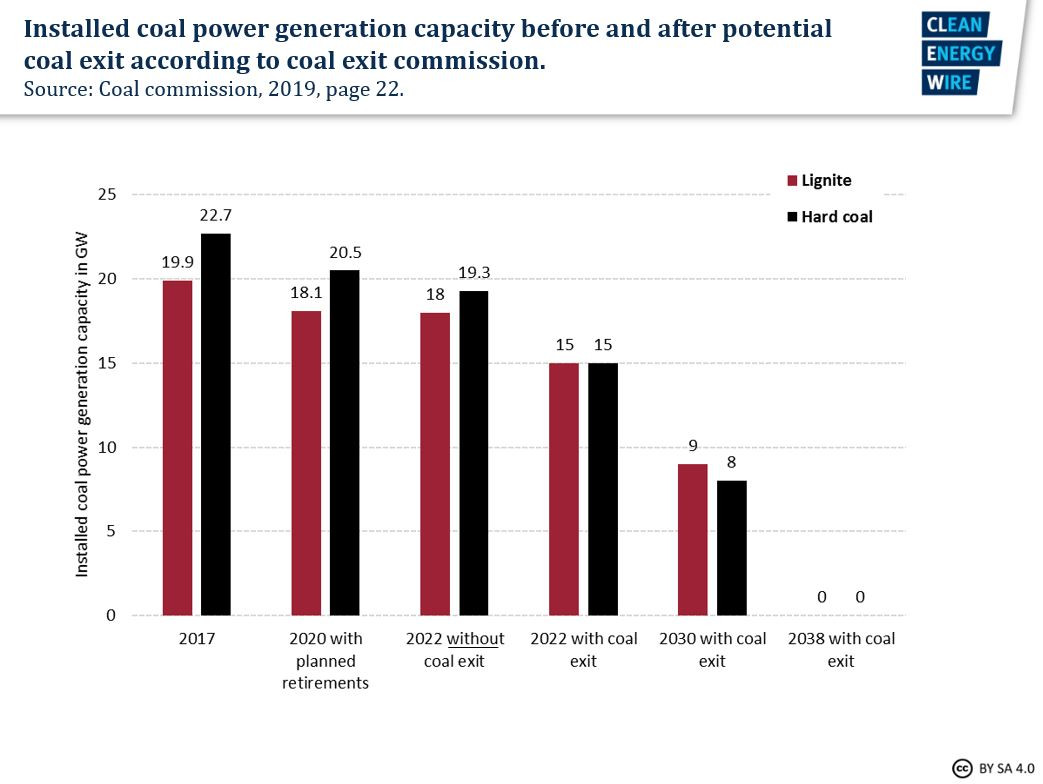Implementing Germany’s coal exit proposal
Also read our full package on Germany's coal exit in the dossier Europe's largest economy aims to exit coal to reach climate goals. To stay abreast of most recent developments, search for the hashtag #coal, and also follow us on twitter @cleanenergywire.
Government must translate proposal into action
In late January 2019, Germany's coal exit commission agreed on its highly anticipated phase-out proposal and recommended to end coal-fired power generation by 2038 at the latest. On almost 300 pages, the commission provided detailed suggestions on a wide range of aspects, but at the same time also omitted crucial questions – such as which power plant should be switched off at what time.
From the onset, the commission’s final report was meant to serve as a general blueprint for political decision-making rather than a detailed manual on how to proceed. However, according to the commission's leadership, the proposal takes the interests of all main stakeholders into account, which is why it urges the government to follow its recommendations as closely as possible.
The structure of Germany's federal political system brings with it that both the federal parliament (Bundestag) and the council of state governments (Bundesrat) have to give their consent to many aspects in the legislative process of a coal phase-out. [This factsheet gives a brief overview of German law-making on energy and climate issues.]
In the end, state governments will have to implement the coal exit at regional level, for example through licensing future lignite mining projects or deciding which infrastructure investments are most pressing to give the regions an economic perspective that goes beyond coal.
Before parliamentarians get involved, however, the federal government first had to decide which details of the process it aims to adopt and draft relevant legislation. Chancellor Angela Merkel's government remained rather vague for some time. It started by “closely and constructively reviewing” the commission’s final report, while signalling general support. “The fact that a commission made up of such different societal groups has found an agreement and created a framework is an important message for us. We will handle this very carefully,” Merkel said.
With the Climate Action Programme 2030, which the cabinet adopted in October 2019, the government officially accepted the commission's recommendations. The government said it will "implement [the coal commission's consensus] in close coordination with the federal states.” Thus, the coal exit is also one element of the climate package meant to ensure that Germany reaches its 2030 targets.
The government presented a first set of key decisions on structural economic support of the coal regions in late May 2019, then a draft law in August, which is now being debated in parliament. In mid-January 2020, the German government, coal mining states and several major utilities agreed on a roadmap for shutting down the country's lignite-fired power plants and on compensation payments for operators. This agreement paved the way for the economy ministry to finalise its draft "Coal Exit Law". It is set to be adopted by the cabinet on 29 January and will then be sent to parliament.
Twofold implementation process
The process of implementing the phase-out is split up into two fields of action:
A. Structural economic change – support for lignite mining regions
B. Energy and climate policy legislation
Germany will need two major laws to implement the phase-out plan. One on support for mining regions, the other on the timetable for coal-fired power plant shutdowns - the coal exit law. However, several additional laws, amendments to existing legislation or regulatory changes will be necessary.
A. Support for mining regions
From the beginning, the economic future of lignite mining regions was considered a key task of the coal exit commission, as reflected in its official title “Commission on Growth, Structural Change and Employment.”
The government adopted a draft law (“Strukturstärkungsgesetz Kohleregionen”) in August 2019 submitted by minister Altmaier, which is aimed at strengthening the mining regions following the country’s coal exit. It would allocate up to 14 billion euros in grants to the lignite mining regions until 2038. The grants are aimed at stimulating the economy in a wide range of areas, such as business-related infrastructure, improvement of public transport, broadband and mobility infrastructure, environmental protection and landscape management.
Additionally, the federal government would support the regions with up to 26 billion euros through further measures, such as the expansion of research and development programmes and the establishment of federal institutions. The government plans to speed up the expansion of transport infrastructure in the regions. The economy ministry will oversee a newly created high-level federal and state body that will play a central role in ensuring a rapid flow of projects. The government aims to lay the groundwork for the coal regions to "use the coal exit as an opportunity” and "turn into modern energy and economic regions,” said minister Altmaier.
The draft is currently being considered in both the Bundestag and the Bundesrat.
B. Energy and climate legislation
The implementation of the coal exit commission’s proposals for the energy sector requires the amendment of several existing laws, such as the Renewable Energy Act (EEG) or the Combined Heat and Power Law (KWKG). However, the main piece of legislation will be a “coal exit law” which deals with hard coal and lignite plant shutdowns.
The timetable for shutting down coal-fired power plants is among the most contentious pieces of legislation as individual regions, companies and jobs are directly affected.
The government has said that lignite and hard coal would be handled with different measures because of differences in emissions intensity and because hard coal has to be imported, while lignite is mined close to the power plants, so a phase-out will have significant economic consequences for the regions.
The economy ministry sent a first draft of the coal exit law, included in a wider package of energy legislation amendments, to the other ministries for coordination in November 2019, as negotiations about compensation payments with lignite operators were ongoing. The draft stipulated auctions for hard coal plant operators to receive a "hard coal premium" for capacity volumes they offer to take offline. Other aspects of the package - such as planned national minimum distance rules for wind turbines from the nearest settlement - were heavily criticised and subsequently separated from the coal exit law package.
In January 2020, the government, coal mining states and several major utilities agreed on a shutdown schedule for lignite-fired power plants and on compensation payments for operators, clearing the last hurdle for a coal exit law draft encompassing both types of coal.
Former coal commission members said the agreement violates the 2019 coal compromise and demand that the plan is adjusted to bring about quicker emissions reduction and comply with the country's climate targets.
Despite the criticism, the economy ministry went ahead and send the coal exit law draft to associations for comment on 22 January. The government cabinet is scheduled to agree a final draft in a meeting on 29 January, before it is then send to parliament.
The economy ministry said the legislative process should be concluded in the first half of 2020, but this depends on proceedings in parliament.



